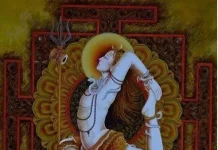The Rigveda is the oldest of India’s ancient Vedic texts, extending back to 3000 BCE or earlier. It is our doorway into the mind of the ancient Rishis and sages who were said to have created the paths to higher Consciousness at the beginning of this world age. Today in the twenty-first century, the Rigveda remains of profound relevance, providing not only keys to the origins of civilization but a cosmic vision that transcends all time, connecting humanity to the power of universal creation.
By Dr David Frawley
The Rigveda is the oldest surviving text from the ancient world, which best preserves the voice and message of our ancient ancestors and spiritual guides, lauded in many ancient traditions throughout the world. As such, it forms a unique living link with our ancient origins and our spiritual ancestors.
The Rigveda is a massive and diverse teaching, containing over one thousand hymns and ten thousand verses in cryptic mantras. It holds the hymns of dozens of great Rishis, famous throughout the history of India. These include such renowned figures as Vasishtha, Agastya, Vishvamitra, Vamadeva, Atri, Kanwa, Bharadvaja, Atharva, Bhrigu, Angiras, Kashyapa, Ushanas, Parashara, Narada and many more.
Ancient sages and seers, often seven in number, are lauded throughout the world for their wisdom and influence on civilization. If we wish to hear their message in their own language, we must listen to the chants of the Rigveda and meditate deeply upon them.
The Rigveda is also a book of great kings, mentioning numerous great kings like Sudas, Divodasa, Bharata, Mandhata, Purukutsa, Trasadasyu and Kuru, many lauded as Chakravartins, emperors of India from sea to sea. Indeed, for such a large literary collection to survive over many centuries required the patronage of enduring dynasties.
The Living Vedic Tradition
Yet most significant is the fact that the Rigveda is still chanted today and has been continually since its compilation thousands of years ago. This claim cannot be made for any other book in the world of such great antiquity. Not only chanted, it still forms the basis of meditation and mantra practices leading to the highest Self-realization used throughout India.
The Rigveda has been preserved in its original pronunciation by a strict set of rules, annotations and styles of chanting. It exists along with several traditional methods of interpretation that provide inner keys to its inner meanings, which are hidden to the ordinary mind.
The Rigveda is a mantric text, meaning it is poetic, symbolic and imagistic and has several levels of meaning, not easy to grasp by the outward looking modern intellect. The Sun is the visible face of the Divinity, the Atman or the inner Self of the entire universe. Agni is not just a material fire but is the very light of consciousness within us. Soma is not just a plant but the Divine Bliss or Ananda. Vayu is not just the wind but the comic energy in all its forms. The Vedic ritual or yajna is not just an outer fire ritual but inner offering of speech, prana and mind into the Divine flame within us, the basis of the practice of Yoga.
Interpreting the Rigveda Today
There has been extensive research, study and translations of the Rigveda since the colonial era that began to examine the text from a European perspective. Yet it would be wrong to think that the essence of the Rigveda has been understood or even agreed upon by scholars, particularly those from outside the Vedic tradition. Western scholars have a very different estimation of the text than Vedic scholars or Yogis. Whereas they tend to look upon the Veda as primitive nature worship, Vedic scholars see in it a mantric key to the cosmos and to our own inner Self, with all of nature as a manifestation of the Divine Word.
Several great gurus of modern India have emphasized the Rigveda and its continued relevance. These include such towering figures as Swami Dayananda Sarasvati of the Arya Samaj, Sri Aurobindo, Kavyakantha Ganapati Muni, chief disciple of Ramana Maharshi, Brahmarshi Daivarata, Kapali Shastri, Sri Anirvan and Swami Veda Bharati, whose disciples have expanded their Vedic interpretations.
So how does one approach the Rigveda today many thousands of years later in a very different civilization? Vedic texts say that the mantra OM is the essence of the Vedas and we can understand the Vedas through chanting and meditating upon OM alone, connecting us to the power of cosmic sound.
Several Rigvedic verses remain commonly chanted in Hindu and yogic circles today. These include the famous Gayatri Mantra of Vishvamitra, which is the prime mantra of the Hindus used for agnihotra or daily fire offerings. Another is the Mrityunjaya Mantra to Shiva of Rishi Vasishtha that is one of the key chants for the worship of Lord Shiva. The Hamsa mantra of Rishi Vamadeva is another point of inspiration.
Some complete Vedic hymns like the Purusha Sukta, Nasadiya Sukta (creation hymn) or Vak Sukta (to the Goddess of Speech) are still widely studied. Many Vedic verses occur in in later Vedic texts. For example, Rishi Vamadeva’s statement “I was Manu and the Sun”, is quoted in the Brihadaranyaka Upanishad relative to the great statement (Mahavakya) Aham Brahmasmi, or “I am Brahman”.
Therefore, one must ask, if these few mantras of the Rigveda can be so transformative, what about the rest of its ten thousand verses, which are cast in a similar language and cadence and reflect the same depths of meaning?
As humanity’s oldest book, the Rigveda remains its most mysterious. It requires much more research to uncover its wisdom and its power, which means an honoring of the ancient Rishis through whom it was expressed, and reseach through meditation, not simply conceptual or historical studies.
A new examination of the Rigveda is one of the most important intellectual and spiritual endeavors today, necessary for humanity to discover its true spiritual origins and destiny, which is to realize Universal Consciousness within us. The Rigveda can help us reclaim our higher purpose as a species, which is to aid in the evolution of Consciousness on Earth, not simply control the world around us.
Article Courtesy : www.vedanet.com












